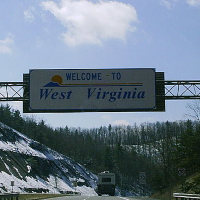
Speaking to a crowd in West Virginia, President Donald Trump oversold the economic progress in the Mountain State on two fronts:
- Trump said West Virginia “is second in the nation in the percentage increase of GDP.” That was true at one time, but West Virginia ranked 44th in the most recent quarter. For all of 2017, West Virginia’s GDP ranked 10th.
- Trump also said that “in West Virginia, per capita personal income grew more than 40 percent faster than the national average.” That’s a bit misleading. Per capita personal income in West Virginia — which is 25 percent lower than the national average — grew just $65 (or 5.5 percent) more than the national average.
West Virginia’s GDP
Trump’s comments were made at the Salute to Service Dinner at the Greenbrier Resort in White Sulphur Springs, West Virginia – a state he won by 42 percentage points and frequently visits.
This is not the first time the president has said West Virginia has the second-fastest growing Gross Domestic Product. He said it in December 2017 – five months after the Bureau of Economic Analysis said, subject to future revision, that West Virginia’s economy grew at an annualized rate of 3 percent in the first quarter of 2017 – second only to Texas.
But that was a snapshot in time. West Virginia no longer has the second-fastest economy – even though the president continues to say it does.
Trump, July 3: Do you know that West Virginia is second in the nation in the percentage increase of GDP? Think of what that means. And Jim just said, “Before we met Trump, that number was not good.” Pretty close to last, right?
… But now, think of that. Texas was first. Texas. Doing a great job. Great governor there, too. But Texas was first. West Virginia was second — percentage increase of GDP. That’s an incredible accomplishment in a short period of time. Incredible.
The Texas economy did rank first in the fourth quarter of 2017, growing at an annual rate of 5.2 percent, according to the BEA’s most recent state estimates released in May. But West Virginia’s real (inflation-adjusted) gross domestic product grew by just 1 percent, significantly lagging the 2.7 percent nationwide average, and ranking 44th among states that quarter.
However, quarterly figures can fluctuate dramatically.
For the entirety of 2017, West Virginia’s real GDP rose by 2.6 percent. (See Table 4.) That was better than the national average of 2.3 percent, but puts West Virginia 10th among states — not second.
It is, however, an improvement. As Trump noted, West Virginia’s economic growth dramatically trailed the national average in each of the three years prior to 2017.
But Brian Lego, an economic forecaster at West Virginia University’s Bureau of Business and Economic Research, told us the state’s economic improvement has not been driven by any policies from the Trump administration.
Much of the turnaround in the state’s economy is tied to the energy industry, Lego said, particularly coal and natural gas (a conclusion also reached by the BEA). On the coal side, a small uptick after years of decline was largely due to an improvement in the international trade market that resulted in “a decent pop in coal production,” Lego said. The state started seeing that improvement for coal in the second and third quarter of 2016, Lego said, before Trump took office; and it has continued under Trump’s presidency.
The state also benefited from some improvement in the domestic natural gas market, he said.
Personal Income
Trump’s claim about West Virginia greatly outpacing the nation in per capita personal income growth begs some context.
Trump, July 3: Last year, in West Virginia, per capita personal income grew more than 40 percent faster than the national average.
According to the Bureau of Economic Analysis, per capita personal income in West Virginia rose from $36,673 in 2016 to $37,924 in 2017. That’s an increase of $1,251, or 3.4 percent.
Nationally, per capita personal income rose from $49,213 in 2016 to $50,399 in 2017. That comes to an increase of $1,186, or 2.4 percent.
West Virginia’s per capita personal income in West Virginia grew just $65 — or 5.5 percent — more than the national average.
How does Trump arrive at his 40 percent figure?
West Virginia’s rate of growth was faster than the nation, because the state’s per capita personal income still trails the national average by about 25 percent. It ranks 49th in the U.S.
So, West Virginia’s per capital personal income, even though it was only $65 more than the national average, grew by 3.4 percent — 1 percentage point, or 40 percent higher, than the national average of 2.4 percent, as the president said.
The post Trump Overstates West Virginia Gains appeared first on FactCheck.org.

